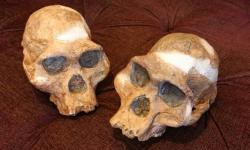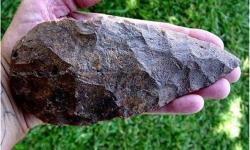Welcome to the world?s richest hominid site and world heritage treasure, The Cradle of Humankind, only 50 minutes away from Johannesburg and 25 minutes from Lanseria International Airport, near Krugersdorp in the Gauteng Province in South Africa.
The Cradle of Humankind was declared a World heritage site in 1999 due to the vast numbers of well preserved fossils and stone tools of hominids (humans, their ancestors and bi-pedal relatives) telling the story of human origin and heritage was found here in Krugersdorp.
There are 15 major fossil sites in The Cradle of Humankind, from more than 3.3 million years ago through early and late stone-age and up to the present day, Sterkfontein Caves being the most famous. The fossils ?Mrs Ples? and ?Little Foot? were both discovered here, as well as thousands more fossils of hominids, plants and animals.
The oldest hominid fossils from the Cradle are and belong to the genus Australopithecus, which lived in Eastern and Southern Africa the famous fossil skull of an Australopithecus Africanus, "Mrs Ples", was discovered at the Sterkfontein Caves by palaeontologists Dr Robert Broom and John Robinson in 1947. ?Mrs Ples? is about 2.8-million years old. In 1997, palaeontologist Professor Ron Clarke and his assistants Stephen Motsumi and Nkwane Molefe, discovered the full skeleton of an Australopithecus inside the Sterkfontein Caves, encased in breccia, a type of rock. This skeleton, called ?Little Foot?, who lived here around 3 million years ago, is still being excavated.
After Australopithecus came the genus Homo, to which we humans, Homo sapiens, belong. The earliest named Homo species is Homo habilis or ?handy man?, which researchers believe made the first stone tools. Homo habilis emerged about 2.5-million years ago. After Homo habilis came, among others, Homo ergaster, Homo erectus, Homo heidelbergensis, Homo neanderthalensis, Homo floresiensis and Homo Sapiens ? us. These species lived in different parts of the world. Not all Homo species were direct ancestors of humans. The human family tree has many branches, several of which broke off as species became extinct.
Modern humans, Homo sapiens, emerged only about 200,000 years ago. While older species of Homo, such as Homo erectus, lived in Asia and Europe mostly, scientists believe that modern humans, like our most distant ancestors such as Toumai and the australopithecines, evolved here in Africa.
Maropeng...the place where we once lived:
Maropeng means ?returning to the place of origin? in Setswana, an indigenous language in this area of South Africa. Our ancestors have lived in this area for more than 3-million years - the birthplace of all humanity!
The Maropeng Interpretation Centre is an exciting, world-class exhibition, focusing on the development of humans and our ancestors over the past few million years, in an entertaining and educative way.
On arrival, you see a massive burial mound called the Tumulus, which is the entrance to learning the secrets of our ancestry. The development of Maropeng was based on the theme of discovery. At the entrance to Maropeng seven concrete columns signifying the centre. The marketplace and an amphitheatre are sunken into the ground, and this too is buried. The hi-tech and futuristic architecture of the Tumulus resembles the evolution from stone age to modern age!
Sterkfontein Caves:
Finding the almost complete skull of an adult proto-human, now known as Mrs Ples, in 1947 put Dr Robert Broom and the Sterkfontein Caves on the world map. Clocking in at almost 4 million years old Little Foot is a million years younger than Mrs Ples but getting as well known. The almost complete ape-man skeleton were found by Ronald Clarke and Phillip Tobias in 1995 and is still being chipped out carefully to remove it safely from the dolomite in which it was protected for so many millennia. Open to all visitors is Sterkfontein Caves itself where guided tours are available on every half an hour to visitors to the Gauteng province.


The Cradle of Humankind reviews
Login to comment